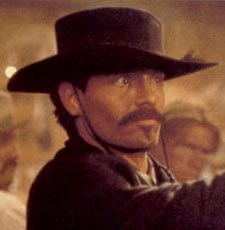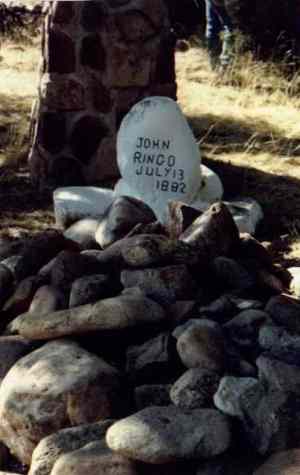
Johnny Ringo. You may remember him in the Film Tombstone, played by Michael Biehn. The death of the real Johnny Ringo is actually a mystery. Suicide or Murder?
Scene of Death-Ringo was found with his back leaning against a tree. In his right hand was clenched a .45 caliber Colt was clenched and he had a gunshot wound in his right temple. The bullet had exited out of the top of his head.
Suicide-John Ringo was in Tombstone on July 2, 1882. He appeared depressed and was drinking heavily. On July 8, he left Tombstone for the last time. Ringo was seen in Galeyville late in the night on July 9. He continued to drink heavily. By July 11, he had left the town. On July 14, 1882 ,the notorious John Ringo was found dead at a tree by teamster John Yoast. The coroner's report commented that his death was "supposed" to have been by suicide.
Murder- There were some strange details concerning his death. He was found with his boots off, and strips of an undershirt were wrapped around his feet. The men that viewed the body concluded that he must have traveled a short distance in this footwear. They also noted that one of his cartridge belts was on upside down. There appeared to be a cut on his scalp with a small part of his hair gone. His horse was not at the scene, but it was found a couple weeks later, still saddled.
Details written out on his death: "There was found by the undersigned John Yoast the body of a man in a clump of Oak trees 20 yards north from the road leading to Morse's mill and about a quarter of a mile west of the house of B. F. Smith. The undersigned viewed the body and found it in a sitting posture, facing west, the head inclined to the right. There was a bullet hole in the right temple, the bullet coming out the top of the left side. There is apparently a part of the scalp gone including a small portion of the forehead and part of the hair, this looks as if cut by a knife. These are the only marks of violence visible to the body. Several of the undersigned identify the body as that of John Ringo, well known in Tombstone. He was dressed in light hat, blue shirt, vest, pants and drawers, on his feet were a pair of hose and undershirt torn up so as to protect his feet. He had evidentially traveled but a short distance in this footgear. His revolver he grasps in his right hand, his rifle rested against the tree close to him. He had on two cartridge belts. The belt for the revolver cartridges being buckled upside on down."
The Cartridge Theory-The coroner's jury noted that Ringo's pistol contained 5 cartridges. Many people have speculated that this suggests that his pistol had not been fired. This theory is based on the fact that the men who wrote out the statement did not specifically state that one round had been fired. It was customary for only 5 cartridges to be loaded in a pistol during this period. This was done for safety because a pistol whose firing pin rested on a live round, could accidentally discharge if suddenly jarred. However, people were known to carry 6 cartridges in their pistols at times. While perhaps it was customary to load only 5 cartridges in a pistol, men at times did load 6 rounds. Thus, the statement by the coroner's jury is consistent with the conclusion that Ringo's pistol had a spent round in it. In actuality, these men would have realized that Ringo could not have killed himself if no discharged rounds were in his pistol. Wyatt Earp- Many people have speculated that because there was no mention of powder burns on Ringo's face and head that he could not have committed suicide.Today, the most popular claim asserted by writers is that Wyatt Earp (left) killed John Ringo. However, unpublished accounts of Wyatt's claim did not surface until after the 1920s. According to Frank Lockwood's book "Pioneer Days in Arizona" (1932), Wyatt told him "in circumstantial detail how he killed John Ringo." Lockwood wrote that Earp told him that he had killed Ringo and Curly Bill when he left Arizona. However, Curly Bill, if he was killed by Earp, supposedly died on March 24, 1882, and John Ringo was found dead on July 14, 1882 - over three months apart. Some Wyatt Earp writers and historians dispute whether Lockwood had been told this by Wyatt Earp. Instead, insisting that Wyatt never made the Ringo kill claim. Wyatt Earp had denied that he had killed Ringo when he was interviewed by a reported in Denver in 1896.
Wyatt Earp- Many people have speculated that because there was no mention of powder burns on Ringo's face and head that he could not have committed suicide.Today, the most popular claim asserted by writers is that Wyatt Earp (left) killed John Ringo. However, unpublished accounts of Wyatt's claim did not surface until after the 1920s. According to Frank Lockwood's book "Pioneer Days in Arizona" (1932), Wyatt told him "in circumstantial detail how he killed John Ringo." Lockwood wrote that Earp told him that he had killed Ringo and Curly Bill when he left Arizona. However, Curly Bill, if he was killed by Earp, supposedly died on March 24, 1882, and John Ringo was found dead on July 14, 1882 - over three months apart. Some Wyatt Earp writers and historians dispute whether Lockwood had been told this by Wyatt Earp. Instead, insisting that Wyatt never made the Ringo kill claim. Wyatt Earp had denied that he had killed Ringo when he was interviewed by a reported in Denver in 1896.



No comments:
Post a Comment